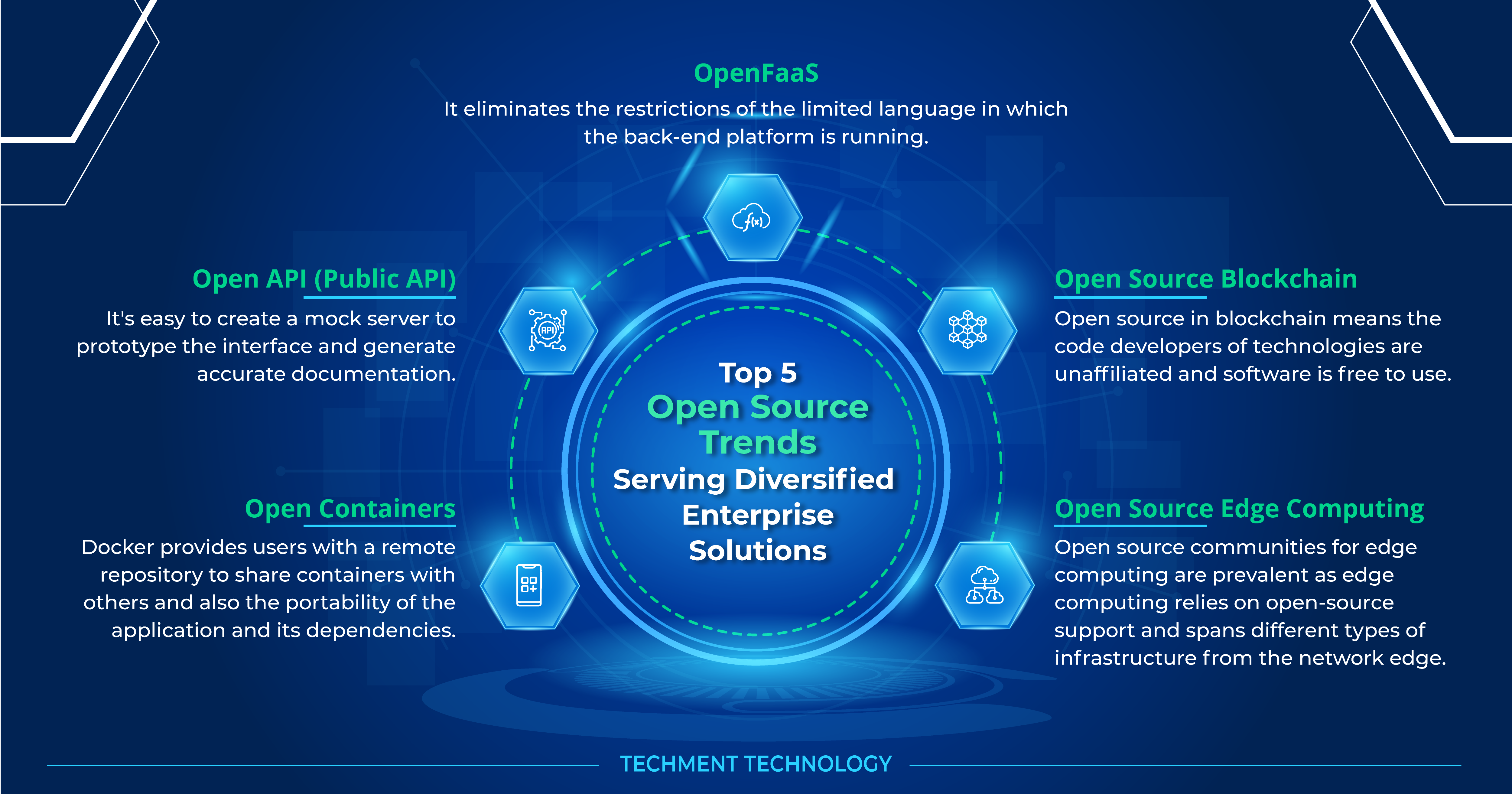It’s About Expanding Opportunities in Open Source
Open source technology has changed the way industries are moving towards innovation in infrastructure modernization, application development, and digital transformation. It has become an innovation engine for the software industry as companies are choosing to innovate the way they are using open source like in security, big data analytics, cloud management, etc. The idea that collaboration and transparency in digital transformation can be provided by anyone has brought IT industries to choose and innovate open source technologies.
Open source refers to something that people receive, can edit, or share as they want, since its design is publically accessible. It can be software, web development, cloud management, and others. The term “Open Source” should not be confused with “Enterprise Open Source”, where the former is open to use, edit or share by the public and licensed by the developer; whereas the latter is backed by enterprise support for quality, security, and software lifecycle management.
A survey done by RedHat shows some top ways of using enterprise open source i.e. 64% in IT infrastructure modernization, 54% in application development and 53% in digital transformation.
Linux is an open-source operating system that receives requests from systems and relays these requests to a computer’s hardware. A research firm, Findly, shows approx 38% of all websites use Linux in 2021 and 96% of the top 1 million websites are believed to be run on Linux-based servers, which is quite impressive.
Why do Enterprises Gravitate towards Open Source?
Open source is evolving through community co-operations, which include programmers, non-programmers, and large companies. Open source licenses affect the way people use, edit, and share the software and it promotes collaboration and sharing. People prefer to use it because they have control over this type of software.
Certainly, the reasons behind using open source are:
- Economical: For enterprises that are budget-challenged or startups must opt for open source platforms. It provides them a better chance to explore different open source solutions. No matter what size the company is, they would always prefer a cost-saving strategy. Netflix is one of the biggest streaming platforms that charge only $ 9 because they focus on providing quality service and not on operating systems.
- Small Start: Starting on a small scale is possible with open source and then scaling it commercially. Whenever a commercially supported solution is required for business then it can be scaled for larger projects. COmpanies also have a chance to pick up alternatives to try for different open-source platforms, if they keep it small.
- Attract Better Projects: Professionals believe that open source attracts many talents who have expertise in building better projects for different purposes. It gives a chance to outside developers to interact with enterprises and provides some better solutions.
- Shared Maintenance Cost: Enterprises don’t have to develop applications of their own and sustain them, rather the community is involved so they share the maintenance cost as well.
Top 5 Open Source Trends Serving Diversified Enterprise Solutions
Open source solutions are serving to be a juggernaut for flourishing application development in the IT industry. With the rise in prominent open-source trends enterprising are coming up with better projects and heading towards more development-oriented solutions.
The overriding open source trends to consider for companies are:

- OpenFaaS: As more companies are moving towards serverless solutions, there is a rise in Open FaaS, since it’s an easier way of using codes written in one standard without worrying about underlying servers and cloud infrastructure. If any command is capable of running through the command line, it can be easily containerized and served as a function through OpenFaaS. It eliminates the restrictions of the limited language in which the back-end platform is running. When applying OpenFaas (originally called Docker FaaS), the API reads the request body and forwards it to the appropriate container, and pipeline the response back to the user.
- Open API (Public API): OpenAPI is the standard format to define RestAPI or HTTP API. This approach is widely accepted by open source and proprietary tools. OpenAPI (originally called as Swagger) provides a simple, consistent structure for API designs which is easy for non-developers to understand and so developers can focus more on meeting users’ demands rather than detailing of API. Using the design document of OpenAPI, the front team can develop a mock API to test integration between application and API. It’s easy to create a mock server to prototype the interface and generate accurate documentation.
- Open Containers: The concept of open containers first emerged in 2015 by the emergence of the Dockers & Open Container Initiative (OCI) which is an open governance structure expressing the purpose of creating open industry standards around container formats and runtime. Earlier docker used all image management, lifecycle creation, resource management, etc. in one place. After implementation of OCI specifications, the image bundle was moved to discrete layers after which management became easier. Docker provides users with a remote repository to share containers with others and also the portability of the application and its dependencies. Kubernetes is also one such open-source container that manages clusters by providing tools for deploying, scaling, and managing the applications. It is extensible as well as fault-tolerant as it allows applications to restart.
- Open Source Blockchain: Blockchain is popular because of its decentralized nature along with greater security (SHA-1) and calling it open source would create a contradiction. Open source in blockchain means the code developers of technologies are unaffiliated and software is free to use. Also, the important reason beyond it is, if a code was developed and implemented by a proprietor or private company, it would need to register with authority to be licensed to transfer the currency. Being open-source, blockchain will still be secure because the complex chain of blocks cannot be altered as the block is distributed across complex nodes of the network and alteration is extremely difficult.
Like the decentralized nature of cryptocurrency (i.e. blockchain and others) makes it popular and that can be seen in blockchain’s value, which is the strongest indicator of its security. Hyperledger is one such open source community hosted by Linux Foundation that focuses on the development of stable frameworks, tools, and libraries for blockchain deployment. - Open Source Edge Computing: The rise of open source at the edge is flourishing as none of the devices in clusters are alike and require a high degree of customization. Open source platforms in edge computing establish an open, interoperable framework independent of hardware, cloud, and operating system. Open source communities for edge computing are prevalent as edge computing relies on open-source support and spans different types of infrastructure from the network edge.
Mobile edge computing or multi-access edge computing (MEC) is one use case of open source edge computing which is specifically used in 5G RAN. The purpose is to create a standardized open environment that will allow efficient and seamless integration of applications from vendors.
The research and development of open-source services is built around a strong and healthy community. However, premium open source projects have become popular with major cloud service providers as they can repackage those projects as cloud services for their customers. Cloud service providers will have to contribute more in return so that they can continue to make a profit.
Strategizing for Cost Efficiency & Productivity with Influence of Technologies in Open Source
Using open-source, companies can create a comprehensive tool that meets their specific business requirements at significantly less cost and in less time and can also take advantage of future development by combining customized solutions with any of the open-source projects.
The low cost of acquiring and using open source software contributes to the rapid adoption of many open source technologies. Enterprises must seek innovative vendors who continue to develop their interoperable open source services to give them an edge over companies that don’t. It’s always better to ask the vendor, what guidance and support do they provide to effectively change your IT infrastructure using proven best practices.
Since the industry services are now more personalized with the help of intelligent technologies, open-source developers will also be able to utilize it for more personalized software which will demote the need for traditional software. This will mark more “predictive” and “personalized” apps. The industry will continue to see data as the next big thing to revolutionize the industry and even take data towards evolution in the form of Database as a Service (DBaaS). DBaaS allows users to configure, deploy, and maintain databases through a user interface or API that removes much of the implementation complexity from the database. If the open source can provide usability for developers in DBaaS, it will capture a significant market share.
The future of open source will be more necessity-driven and companies will need to utilize it to stay relevant which brings it in the center more than ever. The good thing about open-source is, it will never be restricted to one technology rather will keep growing with different resources and technologies.
 All Posts
All Posts

